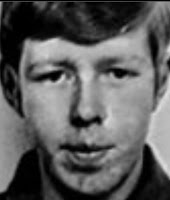Patterns of Evidence II - His lunchbox in one hand and a set of tools in the other
The IRA were not Wild West style gunslingers who challenged the local lawman to a shootout at high noon. Their modus operandi was to engage them while off duty and effectively defenceless or, particularly when it came to the RUC, to murder them while on duty but unable to defend themselves (like David Ead - shot in the back of the head on a seaside promenade on a sunny day before the murderers made off through the crowds).
You can review the cases of off duty murders we have covered to date on the twitter account here.
When Republicans point out that a relatively small percentage of murders by the PIRA in border areas had no security force connections they ignore the fact that Protestants had a strong tradition of serving in the security forces along the border and indeed in the regular armed forces. The Fermanagh based Royal Inniskilling Fusiliers had a history dating back to the 17th century for example.
They also ignore the fact that most of those murdered were either off duty or former members of the security forces.
Given that the UDR hasn’t been around for a quarter of a century there are now a couple of generations who have grown up and generally don’t know even basic details about how the regiment was recruited and operated such as the fact that it was largely part time with members holding down regular civilian jobs. Or that it was unique in the British Army in being recruited entirely within Northern Ireland. There were 258 UDR members or ex-members murdered during the Troubles and only one, Paul Sutcliffe, had a funeral outside Northern Ireland.
With that in mind it is interesting to note that during Operation Harvest in 1956 – 62 the IRA initially made the decision that B Specials would not be targets because of their professed desire to fight a “clean” campaign and not target “ordinary” Protestants (see Professor Henry Patterson’s excellent Ireland's Violent Frontier: The Border and Anglo-Irish Relations During the Troubles).
The campaign post 1969 was markedly different and part time and off duty members of the security forces were very much in the firing line from the off.
 |
| School teacher and IRA murder victim George Saunderson, shot 10 times in the back in his school |
Not only that but past service in the UDR was enough to merit being murdered as George Saunderson found in April 1974, a year after he left the Regiment.
Saunderson was a 58 year old father of 4. Having served during World War II in the Royal Inniskilling Fusiliers and the Parachute Regiment he became the commander of B company of the 4th Fermanagh UDR.
He trained as a school teacher after the war and was principal of Erne Primary School in Teemore.
On the last day of term before the Easter holidays a car pulled up outside the school. Lost Lives quotes a cook in the school kitchen who described what happened next:
“A man got out of the passenger seat beside the driver. He had a gun with him. He walked past me and never spoke a word. Two other men got out of the car and one stood on the outside of the kitchen near the schoolmaster’s house. The other stood beside the car.
“I watched the first man go into the kitchen and I heard him speak to Master Sanderson, who was standing at the hatch which was nearly opposite the kitchen door. He was having a cup of coffee. I heard the man say, “What’s your name?” The master put his hands up and said, “Sanderson”. I knew what was going to happen and I could not look. I heard the sound of shooting and then further shots were fired”.
George Sanderson was shot 10 times in the back.
 |
| Security guard and IRA murder victim Victor Morrow, shot 9 times in the back of the head |
On 25th April 1980 Victor Morrow, a 61 year old from Newtownbutler, was walking to meet a lift to work at a Lisnaskea factory where he worked night shifts as a security guard when he was shot nine times in the back of the head on the road.
Morrow had retired from the UDR a year before his murder.
One final example will suffice by way of illustration. On 13th March 1984 Ronald Funston, a former UDR member, was preparing to feed cattle on his farm near Pettigo on the border with the Republic early one morning.
Let’s allow his mother to take up the story:
“As I was walking towards the silo pits the next thing I heard was automatic gunfire. I was about 75 to 100 yards away. After hearing the shooting the tractor stopped. On hearing this I walked immediately towards where Ronnie had been working, calling his name. As I walked passed a gap in the hedge I noticed two men run across the field towards the border.
“When I arrived I saw Ronnie slumped over the wheel of the tractor in the cab”.
She then went back to the house and told her 74 year old husband to call for help.
Interestingly the Funston murder took place two years after the PIRA issued a statement assuring people that if they left the UDR they would no longer be regarded as targets.
Ronald Funston had left the UDR 8 years prior to his murder.
 |
| Shop assistant and IRA murder victim Jillian Johnstone, shot at least 27 times |
Even an erroneous suggestion that you had family connections to the UDR was enough to merit a death sentence as 21 year old chemist shop assistant Jillian Johnston’s family discovered in 1988. But that is a subject for another blog.
Back to those who were serving in the security forces. The RUC man or UDR woman didn’t live in a barracks. When their shift finished they went back to live in their homes and went about their normal daily lives. In border areas, where the Unionist population were a minority, they were particularly exposed and isolated. The thought that a neighbour might have set a friend or relative up for attack would have caused many sleepless nights.
In terms of the UDR and RUCR almost all were holding down a regular job while serving in the security forces part time.
I did a quick count on Monday of the murders of UDR personnel which I’ve covered and came up with a figure of 75.9% being off duty or ex-members when they were murdered. (Incidentally, the percentage of RUC officers murdered off duty is much, much smaller (under 20% of the cases I have covered). I hope to examine the tactics used to murder RUC officers in future posts).
When looking at tables of statistics of IRA murders remember that the IRA often didn’t murder the UDR man or RUC Reserve officer. They murdered the lorry driver, the bread man, the bin man, the farmer, the milk tanker driver, the postman, the building firm director, the church goer, the engineering plant worker, the father wheeling his child’s bike, the father bringing his little girl to school (and his little girl for that matter), the bus driver, the man down the pub (and the bar man who the IRA said should have known better than to associate with such a person), the golfer, the dog walker, the pigeon fancier, the factory worker and the joiner.
 |
| IRA murder victim joiner Alan Johnston, shot with a "lunchbox in one hand and a set of tools in the other" |
In a nod to Danny Morrison’s infamous declaration that Republicans would take power with a “ballot paper in one hand and an armalite in the other" the Minister at the funeral of the last victim in that list described the murder of part time UDR lance-corporal Alan Johnston, shot as he began his shift at Kilkeel Joinery Works, thus - “An assassin came from behind when Alan was carrying his lunchbox in one hand and a set of tools in the other and, without a chance to defend himself, took his life away.”




Comments
Post a Comment